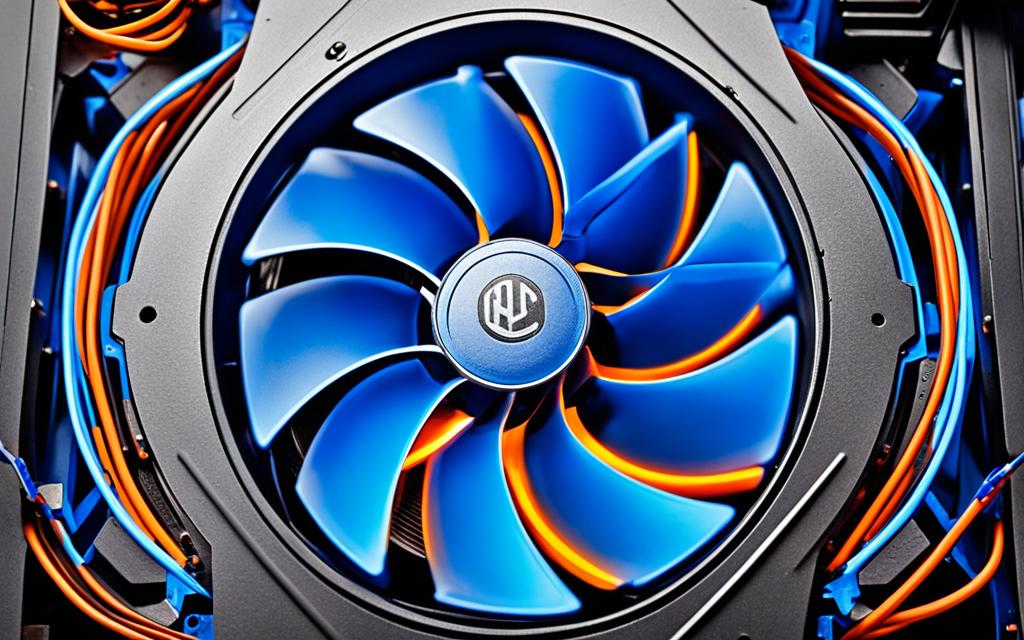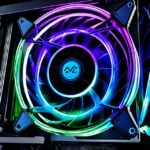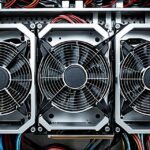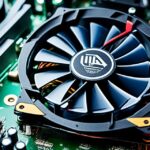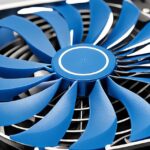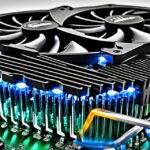Table of Contents
Computers need cool air to work well. Knowing how to set up your case fans correctly is crucial. Here we cover the basics of case fans, including sizes, CFM, RPM, and noise. We also guide you on how to figure out fan direction and give easy installation tips.
Key Takeaways:
- Correct PC fan setup is key for good airflow and top performance.
- Most PCs use positive pressure setups, having more intake than exhaust fans.
- In some cases, a negative pressure setup is better, with more exhaust fans1.
- Think about noise, efficiency, and looks when picking fans, both cheap and pricey.
- High-end PC fans cost about 20 to 40 USD each2.
- There are cheaper fans like Cooler Master JetFlo 120 and Enermax Cluster Advance Cooling.
- Using PWM splitters helps control speed for several fans at once2.
- Place fans wisely in your PC for the best airflow, considering their RPM2.
- The Swiftech 8-Way PWM Cable Splitter is good for handling many fans2.
- Don’t spray paint fans; it can make them unbalanced and noisy2.
- Choosing LED fans depends on your personal taste and the look you want2.
- Use quality tools for repairs to make them easier and safer2.
- Be careful with tools to prevent accidents and keep them working well2.
- Collect good tools over time to make your workshop better2.
For more details on PC fan airflow and why it matters, visit this article.
Case Fan Basics
Before you pick your case fans, knowing some basics is key. Most computers come with fans already. But choosing the right one for your computer is vital.
Fan size is measured in millimeters and matters a lot. You’ll see sizes like 120mm, 140mm, and even 200mm3. Big fans often move more air quietly compared to small ones.
A fan’s airflow capacity is shown in CFM (Cubic Feet Per Minute). This tells you how much air it can move. Fans with over 50 CFM3 are usually effective. More CFM means better cooling.
The rotations per minute (RPM) tell us how fast the fan spins. Fans with a high RPM are powerful but can be noisy. Finding a middle ground between RPM and quietness is key for cooling.
If noise bothers you, check the noise level measured in decibels (dB). Fans quieter than 30dB3 won’t disturb much.
Setting up your fans right is all about airflow. A mix of intake and exhaust fans keeps your PC cool. Typically, you’ll want two intake fans for cool air and exhaust fans to push hot air out4. Good airflow keeps your PC running smoothly4.
| Fan Size | CFM (Cubic Feet Per Minute) | RPM (Rotations Per Minute) | Noise Levels (dB) |
|---|---|---|---|
| 120mm | 50 CFM and above3 | Varies | Below 30dB3 |
| 140mm | 50 CFM and above3mk> | Varies | Below 30dB3 |
| 200mm | 50 CFM and above3 | Varies | Below 30dB3 |
Choosing the right fans and knowing how they work is crucial. It helps keep your PC cool and running well.
Fan Orientation and Installation
Getting the fan orientation right is key for keeping your PC cool and preventing parts from overheating. Knowing how to correctly set up case fans is vital for good airflow and cooling. It’s essential to match the case mounting points with the fan’s airflow direction. Let’s look at how to properly install fans for the best cooling.
Figuring out a fan’s orientation is easy if it has a small arrow showing airflow direction. The side where air comes in is the intake, and where it goes out is the exhaust. If there’s no arrow, the shape of the blades can guide you. Curved away means intake, and towards you means exhaust. This helps you ensure the fan is positioned right for installation.
Installing case fans is quite simple. Fans usually have screw holes that match up with mounting points on the case. These points are placed to make air flow better and keep things cool. By attaching the fan at these points, it stays secure and works efficiently. Plugging the power cable into the motherboard lets the fan run smoothly.
Not every PC fan blows air the same way. There are “reverse” fans that move air in the opposite direction. These give you more options for setting up your cooling system. Always check the fan’s markings or test it to see which way the air goes. This step makes sure you get the cooling you want for your PC.
Fan Orientation: Achieving Optimal Cooling Efficiency
Choosing the right fan orientation is crucial for keeping your PC cool and running well. Understanding airflow and fan direction boosts cooling and helps your components last longer. Here are some important tips for great cooling:
- Using intake and exhaust fans together makes for effective cooling. 5
- Cleaning fans every few months keeps them working their best. 5
- Good fan setup stops overheating, protecting your system. 5
For the right fan setup, use intake fans at the front or bottom of the case. They pull in cool air. Place exhaust fans at the top or back to get rid of warm air. This way, air flows smoothly, keeping important parts cool. It also stops hotspots that can cause problems. 65
Liquid cooling setups need fans to work differently. Fans should pull in cool air across the radiator and push out warm air. This keeps the cooling liquid effective in taking heat away. 5
When setting up fans, leave enough room around the CPU and GPU. This lets air move freely and stops heat from building up. Keeping things cool is key for them to work right and last longer. 5
| Fan Orientation | Cooling Benefits |
|---|---|
| Intake fans at the front or bottom of the case | Draw in cool air to lower overall case temperature |
| Exhaust fans at the top or back of the case | Expel hot air to prevent heat buildup |
| Fans in liquid cooling systems | Pull cool air over the radiator and expel hot air out of the chassis |
| Adequate space between fans and components | Maintain cooling effectiveness and prevent overheating |
Learning about fan orientation and installing them correctly is a must for efficient PC cooling. Paying attention to fan direction and setup leads to a stable, well-cooled system. This helps your components stay safe from overheating and last longer.
The Fundamentals of Airflow and Case Pressure
Getting airflow and case pressure right is key to keeping a PC cool. By directing cool air to important parts like the CPU and GPU, we can keep the system efficient. This means understanding positive and negative case pressure to get the best cooling.
Positive case pressure happens when more fans blow air in than out. This stops dust from getting inside by pushing air through any gaps. It helps air pass through filters too, keeping the inside clean and cooling it better.
Negative case pressure means more air is blown out than in. This is good for getting rid of heat, especially with the right fan setup. The pull of air helps remove warm air, which is great for PCs that run hot.
Balance is crucial when choosing fans for intake and exhaust. Typically, cool air is pulled in from the front and hot air is pushed out the back. This keeps fresh air coming to key parts and heat moving away. Placing exhaust fans at the top also helps, since hot air rises. This design maximises cooling and helps the PC run smoothly for longer.
Using filters on intake helps keep the system clean. Dust can block air and make cooling less effective, so keeping filters clean is important. Cleaning or changing filters regularly protects the PC from overheating and damage.
While side fans are good for extra cooling, they often lack filters. Making your own filters might be needed to prevent dust. This keeps the system cool and working well over time.
Statistical Data:
– Fans are measured by how much air they move in cubic feet per minute (CFM)7.
– More fans mean more air moved, improving airflow7.
– It’s important where fans are placed. Front fans bring in air, back fans push it out7.
– Exhaust fans work best at the top because hot air goes up7.
– Dust can block air flow. So, keeping filters clean is key7.
– Side fans should have filters to stop dust. You might need to make these filters yourself7.
| Configuration | Components | Performance |
|---|---|---|
| Initial setup | GTX 1080 | Fairly quiet and cool |
| System upgrade with 2080 Super | Additional bottom front fan | Improved cooling performance |
| Transition to the i9-11900k and EVGA z590 FTW | Water-cooling system with 420mm EK radiator and 5 fans | Enhanced cooling efficiency for new components |
| Issues with the 3080ti | Difficulty managing significant heat output | Further adjustments required for effective cooling |
| Ultimate cooling solution | MO-RA3 420 radiator setup with Silent Wings Pro 4 fans | Optimized airflow and cooling capacity for high-performance system with 13900k CPU and 4090 FE GPU |
Knowing about airflow and case pressure is key to a top-notch cooling system in a PC. By choosing the right fans, balancing pressure, and keeping filters clean, we can cool our system better. This makes our PC more reliable and extends the life of its parts.
Common and Ideal Fan Arrangements
For optimal cooling, various fan arrangements are key. The best setup draws cool air in and pushes hot air out. Different setups bring unique benefits based on fan number and placement. Let’s look into some common setups and how they help with cooling.
- 1. Front/Rear/Top/Bottom Configuration:
In this setup, fans are at the front, rear, top, and bottom of the PC case. Front fans pull cool air inside. The rear and top fans push hot air out. Bottom fans can either pull in more air or help push air out. This makes for balanced airflow, which cools efficiently3.
- 2. Front/Rear/Bottom Configuration:
This popular setup uses front and rear fans like the first one. Front fans are for intake; rear fans for exhaust. Here, bottom fans only pull air in. This creates positive pressure, forcing hot air out through any gap. It leads to great cooling3.
- 3. Front/Rear Configuration:
A simpler approach has just front and rear fans. Front fans draw cool air in, while rear fans push hot air out. It cools well but may not balance airflow as the other setups do3.
Choosing the Right Fan Arrangement
Choosing a fan setup for your PC is crucial. You need to think about airflow and whether you want more air coming in or going out. More air in (positive pressure) means less dust and efficient cooling. More air out (negative pressure) may bring more dust but cools better.
For the best cooling, aim cool air straight at the CPU and GPU. Keep your system clean by regularly dusting fans and filters. This boosts airflow and stops overheating38.
In summary, picking the right fan setup is essential for cooling. Options include front/rear/top/bottom, front/rear/bottom, and front/rear. Think about fan placement and pressure to get good airflow. Keep your system clean for the best performance. With the correct setup, your PC will stay cool, even during heavy use3.
Choosing the Right Fans
Choosing the right fans for your PC needs thought on several aspects. The most important ones include comparing airflow to static pressure and looking into noise levels. Let’s delve into these factors more closely.
Airflow vs. Static Pressure
Airflow fans aim to move a lot of air, perfect for cooling your system. They ensure a constant flow of cool air to take heat away from components. Typically, you’d place these fans as intake or exhaust in PC cases. Static pressure fans, however, shine where airflow meets barriers, like radiator fins or HDD cages. They create strong pressure to push air through tight spaces, ensuring efficient cooling.
Statistical data from9 shows fan sizes range from 80mm to 200mm. Bigger fans can push air just as well as smaller ones but are quieter since they spin slower. Knowing your PC’s needs and space limits helps in choosing between airflow and static pressure fans.
Noise Levels
For many PC users, a quiet system is as crucial as effective cooling. Fan noise, measured in RPM, shows that faster fans move more air but are louder. Slower fans, on the other hand, are quieter but less effective in moving air9. If you want a quiet PC, look for fans with lower max RPM or those made to be silent.
Noctua is renowned for quiet, efficient fans. These fans offer a solid noise-to-performance ratio9. They’re a go-to for those valuing both silence and efficiency.
Choosing the Right Balance
Selecting the perfect fans involves juggling performance, noise, and looks. Think about your case size and how many fans it can hold. Good fan positioning ensures effective airflow management9. Put intake fans at the front or bottom to pull in cool air. Exhaust fans should go at the back or top to remove hot air. Avoid obstacles like cables to keep airflow smooth from intake to exhaust9.
Additionally, choosing between positive or negative air pressure impacts cooling. Positive pressure, recommended by1, uses more intake fans to ensure enough cool air. Some prefer negative pressure for better airflow, pulling more air out than in.
Price also matters when picking fans. Prices differ by brand and features. For instance1, gives data on fan pricing. The Arctic P12 PWM 120mm fan pack costs around $30 to $35 for five, so about $6 to $7 per fan. The Noctua NF-A12x25, noted for being quiet yet potent, is $35 each. Lian Li’s UNI Fan V2 SL120 offers a neat RBG setup, allowing for easy daisy-chaining1.
So, weigh your PC’s airflow, static pressure needs, and how much noise you can tolerate. Also, consider your budget. The right fans balance performance, noise, and style, ensuring your PC runs well without sacrificing cooling quality.
Conclusion
Getting your PC fans set up right is key to keeping everything running cool. When you organize your fans well, making sure some pull air in and some push it out, your PC parts won’t overheat. This means they’ll work better for longer.
Most CPU fans push air down onto the cooler, which keeps the CPU temperature down10. The way the fan faces can change depending on the model10. Keeping cables tidy helps air move freely, which makes cooling more effective10. It’s also vital to keep your computer clean to stop dust from blocking the airflow10. Always check the CPU’s heat levels, especially if you’re pushing your system hard or overclocking10.
When you’re setting up your PC, make sure there’s enough space for air to get in and out. Your PC needs more than 40% of its vents for pulling air in and over 50% for pushing air out11. Don’t place fans so they blow air at each other. That messes up the air pressure and makes cooling less efficient11. A tower cooler usually works best for the CPU11. These days, many graphics cards have their own air ducts. They send the hot air straight out the back of your PC11.
To keep things cool, your hard drives should stay between 55°C and 60°C. This helps them last longer11. You can find power supplies that adjust the fan speed based on how hot they get or how hard they’re working11. Planning your PC’s airflow smartly means you might not need extra fans. Or you won’t have to make your existing fans work overtime11.
FAQ
How important is it to arrange case fans for optimal performance?
Arranging case fans correctly is key for your PC’s cooling. It keeps a consistent cool air flow to your components. This means your PC works better and lasts longer.
What are the key terms and specifications to consider when choosing case fans?
When picking case fans, look at fan size, airflow, speed, and noise. Fan size is in millimeters, airflow in CFM, speed in RPM, and noise in decibels. It’s all about finding the best mix for cooling.
How can I determine the orientation of a PC fan?
You can tell a PC fan’s direction by an arrow showing airflow. No arrow? The curved blades can guide you. Blades curving away mean intake; towards you is exhaust.
How do I install case fans?
Putting in case fans is easy. You just screw the fan onto the case. Then, plug the power cable into the motherboard. Your case and fan manual have all the steps.
What is the importance of airflow and case pressure?
Getting airflow and case pressure right is vital for cooling. You want cool air to move over the CPU and GPU, then push hot air out. Balancing case pressure helps this happen efficiently.
What are some common fan arrangements for cooling?
Different fan setups like front/rear/top/bottom work for cooling. Your setup should fit the number of fans and their positions. It’s about getting positive or negative pressure in the case.
How should I choose the right fans for my PC?
Choosing PC fans? Think about airflow, noise, and cooling needs. Airflow fans push air well, static pressure fans work with blockages. If noise matters, pick quieter fans.
What is the importance of PC fan airflow and proper fan installation?
Correct fan setup and airflow prevent your PC from overheating. Properly arranged fans mean your PC stays cool and stable. It’s key to avoiding damage to your hardware.
Source Links
- https://www.pcworld.com/article/394576/how-to-tell-which-way-your-fan-is-blowing.html – How to tell which way your fan is blowing
- https://www.overclock.net/threads/is-there-a-visual-way-to-identify-if-a-fan-is-intake-or-exhaust-mode.1497960/ – Is there a visual way to identify if a fan is intake or…
- https://www.tomshardware.com/how-to/set-up-pc-case-fans-for-airflow-and-performance – PC Airflow Guide: How to Set Up and Position Your Fans
- https://www.cgdirector.com/pc-fan-airflow-direction/ – How to Tell Which Way Your PC’s Case & CPU Fans are Blowing
- https://www.electronicshub.org/pc-fan-airflow-direction/ – PC Fan Direction (PC Fan Airflow Direction)
- https://www.techpowerup.com/forums/threads/how-to-know-the-case-fan-is-input-ouput.301978/ – How to know the case fan is input/ouput?
- https://www.neweggbusiness.com/smartbuyer/over-easy/pc-cooling-how-to-set-up-computer-case-fans/ – PC Cooling: How to Set up Computer Case Fans – HardBoiled
- https://www.edn.com/fan-air-flow-in-cooling-designs-push-or-pull/ – Fan airflow in cooling designs: push or pull? – EDN
- https://www.howtogeek.com/303078/how-to-manage-your-pcs-fans-for-optimal-airflow-and-cooling/ – How to Manage Your PC’s Fans for Optimal Airflow and Cooling
- https://softwareg.com.au/blogs/computer-hardware/which-way-does-cpu-fan-blow – Which Way Does CPU Fan Blow
- https://www.silverstonetek.com/en/tech-talk/wh_airflow – Tech Talk∣SilverStone

